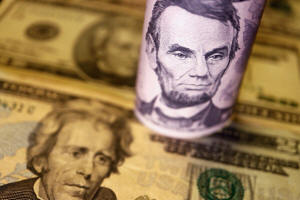Unstable cable
 Send a link to a friend
Send a link to a friend
 [September 26, 2022] A
look at the day ahead in U.S. and global markets from Mike Dolan. [September 26, 2022] A
look at the day ahead in U.S. and global markets from Mike Dolan.
Britain's gamble to spur growth with unfunded tax cuts into an inflation
surge has morphed into a bona fide crisis for sterling and UK government
bonds, with questions for all governments seeking ever more debt-funded
economic supports.
Supercharging an already rampant U.S. dollar around the globe, the
sterling/dollar rate - nicknamed 'cable' by traders - went into virtual
freefall at one point early on Monday.
Foreign investors ran for the exits after the new government's fiscal
plan on Friday threatened to stretch Britain's finances to their limits
and finance minister Kwasi Kwarteng promised even further tax cuts at
the weekend.
Sterling, which has cratered almost 10% peak-to-trough against the
dollar over the space of a week, plummeted almost 5% at one point early
on Monday to a record low against the dollar of $1.0327, breaching its
prior all-time trough of $1.0520 from 1985. While it clawed back some of
those gains as London trading opened, it remains down another 1% from
Friday and was down almost 1% against the euro too.
The pound's plunge comes ahead big auctions of both long-term and
inflation-linked British government bonds this week and increasing
liquidity issues in the gilt markets.
The scale of the pound's losses and fiscal fears has many traders
speculating about emergency rate rises by the Bank of England. Rate
futures now price in a three-quarters-of-a-point hike to 3% on or before
the BoE's next meeting on Nov. 2.

British 10-year gilt yields are above 4% for the first time in 12 years
and the gilt yield premium over German bunds is now homing in on two
full percentage points for the first time in 31 years - levels not seen
since just before the pound was ejected from Europe's pre-euro currency
grid system, the exchange rate mechanism, in 1992.
UK 2-year gilt yield moved above 4.5% - up a whopping 150 basis points
this month and the highest since 2008, and reflecting mounting recession
fears, the UK 2-10 year government bond yield curve is at its most
inverted since the banking crash of 2008.
Although relatively muted minor compared to sterling's drop, the euro
also slipped against the dollar after Italy's weekend general election
looked set to usher in the most right-wing coalition government since
World War Two.
[to top of second column] |

U.S. Dollar banknotes are seen in this
illustration picture taken June 14, 2022. REUTERS/Florence
Lo/Illustration

Ten-year Italian government bond yields climbed close to 4.5% and
are at are at their highest since 2013, in the aftermath of the euro
sovereign debt crisis.
But that move reflected the general selloff in bonds and, in stark
contrast to UK government bonds, yield premia over German bunds were
little changed from Friday as the rightist coalition looked well
short of a two-thirds parliamentary coalition that would allow it to
change the constitution without a referendum.
Dollar pressures mounted everywhere.
After last week's dramatic intervention to buy yen on the open
markets, Japan's Finance Minister Shunichi Suzuki continued to warn
that the country would act again to calm what it saw as excessive
speculative curreency market moves.
China also acted in a different way on Monday to rein in yuan
ongoing slump against the dollar. The People's Bank of China will
from Wednesday raise foreign exchange risk reserves for financial
institutions when purchasing FX through currency forwards to 20%
from the current zero.
With recession looming and inflation and interest rate pressures
inceasing, soundings from European business are darkening and
Germany's Ifo business survey for September was well below
forecasts. Warning of a global downturn ahead, the Organisation for
Economic Cooperation and Development said central banks needed to
keep fighting inflation and saw U.S. Fed rates as high as 4.75% next
year.
As we approach the end of the third quarter, the S&P500 is in the
red for the three months and set to record its third consecutive
quarterly loss since the aftermath of the Lehman Brothers collapse
in 2008.
Key developments that should provide more direction to U.S. markets
later on Tuesday:
* U.S. September Dallas Fed manufacturing index; August Chicago Fed
activity index
* Atlanta Fed chief Bostic speaks
(By Mike Dolan, Editing by William Maclean, mike.dolan@thomsonreuters.com.
Twitter: @reutersMikeD)
[© 2022 Thomson Reuters. All rights
reserved.]
This material may not be published,
broadcast, rewritten or redistributed.
Thompson Reuters is solely responsible for this content. |